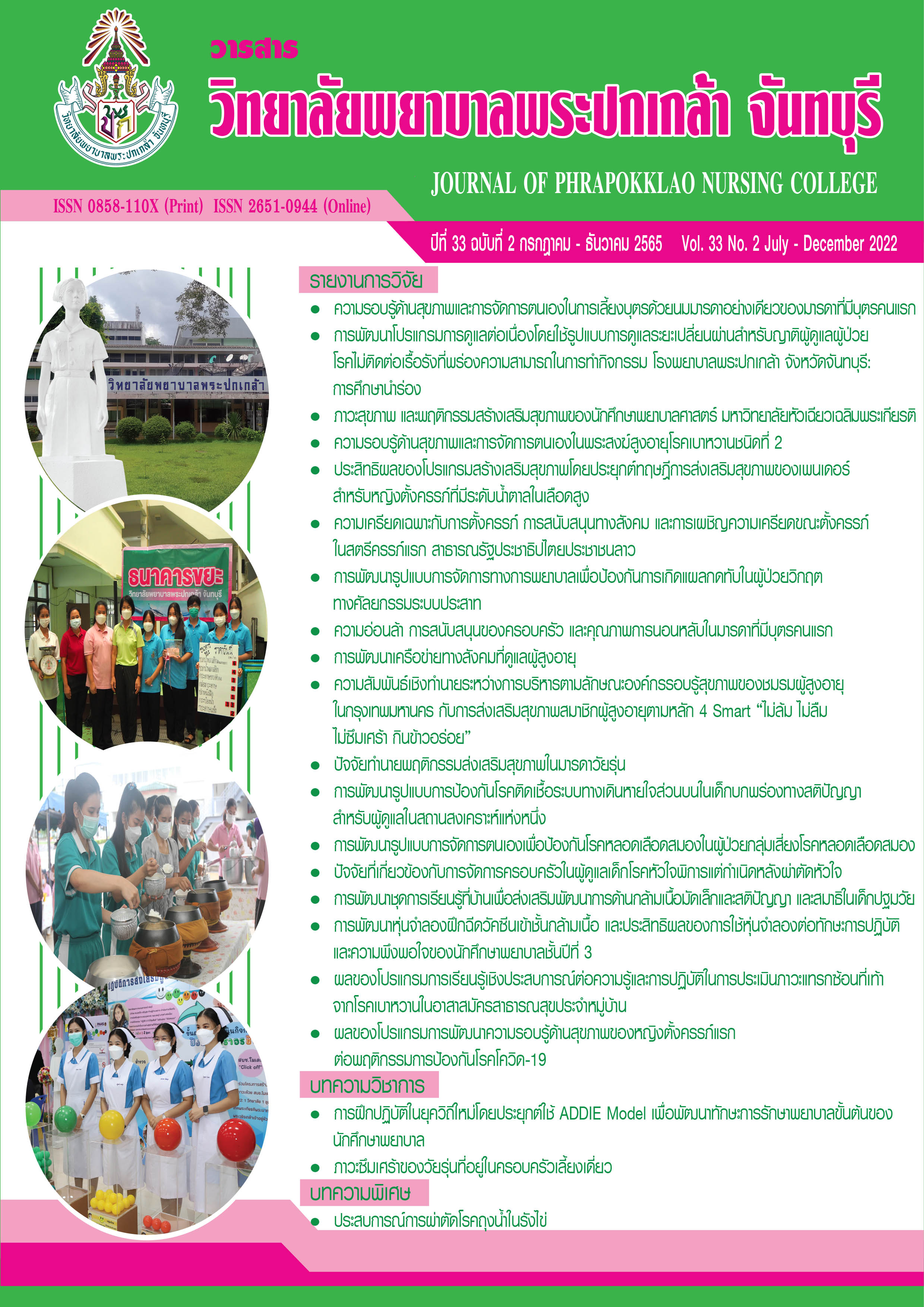Effects of Experiential Learning Program on Knowledge and Practice Regarding Assessment of Diabetic Foot Complications among Village Health Volunteers
Keywords:
Experiential learning, Assessment of diabetic foot complications, Village health volunteersAbstract
This quasi-experimental research aimed to study the effects of experiential learning program on knowledge and practice regarding assessment of diabetic foot complications. The participants consisted of 36 village health volunteers who lived in Doi Saket District, Chiang Mai Province and were divided into the experimental group (n = 18) and the control group (n = 18). The research instruments consisted of an experiential learning program, a general information questionnaire, a knowledge regarding assessment of diabetic foot complications questionnaire with reliability of .78, and a practice regarding assessment of diabetic foot complications observation form with reliability of .83. The implementation and data collection were conducted from June to July, 2020. Data were analyzed using frequency, percentage, mean, standard deviation, paired t-test, and independent t-test.
The research results revealed that 1) after the experiment, the experimental group had statistically significantly higher mean score of knowledge regarding assessment of diabetic foot complications than that of before the experiment and that of the control group (t = 5.420, p < .001 and t = 5.090, p < .001, respectively); and 2) after the experiment, the experimental group had statistically significantly higher mean score of practice regarding assessment of diabetic foot complications than that of before the experiment and that of the control group (t = 6.430, p < .001 and t = 4.370, p < .001, respectively).
This research suggests that community nurses should apply this experiential learning program for improving knowledge and practice regarding assessment of diabetic foot complications among village health volunteers. This will help prevent foot complications in diabetic patients.
References
จิรปรียา บุญสงค์, จีระศักดิ์ เจริญพันธ์, และจิราพร วรวงศ์. (2559). ผลของโปรแกรมส่งเสริมพฤติกรรมการป้องกันภาวะแทรกซ้อนทางเท้าของผู้ป่วยโรคเบาหวานชนิดที่ 2 ที่มารับบริการที่โรงพยาบาลส่งเสริมสุขภาพตำบลดงขวาง อำเภอเมือง จังหวัดนครพนม. วารสารสำนักงานป้องกันควบคุมโรคที่ 7 จังหวัดขอนแก่น, 23(2), 46–59.
ชยพล ศิรินิยมชัย. (2561). การจัดการแผลเท้าเบาหวาน: บทบาทของพยาบาล. วารสารสมาคมพยาบาลแห่งประเทศไทยฯ สาขาภาคเหนือ, 24(1), 1–14.
ชยพล ศิรินิยมชัย, ณัฏฐนิช บุญหนัก, ศรีพรรณ ศรีวงศ์วรรณ, และพิชยา วรรณชัย. (2562). การพัฒนารูปแบบการเสริมสร้างความเข้มแข็งโดยชุมชนเป็นฐาน เพื่อสร้างเสริมพฤติกรรมการดูแลเท้าในผู้ป่วยเบาหวาน ที่มีภาวะเส้นประสาทส่วนปลายเสื่อม ตำบลสันปูเลย อำเภอดอยสะเก็ด จังหวัดเชียงใหม่. วารสารการพยาบาลและการศึกษา, 12(1), 14–32.
ตวงพร กตัญญุตานนท์, อมลวรรณ อนุการ, เบญจมาศ โนวัฒน์, ทศนีย์ คงคล้าย, ศรีจิตรา อินสว่าง, วชิราภรณ์ บรรหาร, และปิยาภรณ์ เวชการ. (2561). การปฏิบัติงานเกี่ยวกับโรคเบาหวานตามบทบาทของอาสาสมัครสาธารณสุขประจำหมู่บ้าน: โรงพยาบาลส่งเสริมสุขภาพตำบลแห่งหนึ่งในจังหวัดสมุทรปราการ. วารสาร มฉก.วิชาการ, 21(42), 1–12.
นิดา มีทิพย์, เดชา ทำดี, และประพิมพ์ พุทธิรักษ์กุล. (2559). ผลของการเรียนรู้เชิงประสบการณ์ต่อความรู้และการปฏิบัติการคัดกรองและการให้คำแนะนำโรคความดันโลหิตสูงของอาสาสมัครสาธารณสุขประจำหมู่บ้าน. พยาบาลสาร, 43(พิเศษ), 104–115.
วิชัย เอกพลากร. (บ.ก.). (2553). รายงานการสำรวจสุขภาพประชาชนไทยโดยการตรวจร่างกาย ครั้งที่ 4 พ.ศ. 2551–2. นนทบุรี: เดอะ กราฟิโก ซิสเต็มส์.
สำนักงานหลักประกันสุขภาพแห่งชาติ. (2557). คู่มือบริหารกองทุนหลักประกันสุขภาพแห่งชาติ ปีงบประมาณ 2558 เล่มที่ 4: การบริหารงบบริการควบคุมป้องกันและรักษาโรคเรื้อรัง (บริการควบคุมป้องกันและรักษาผู้ป่วยโรคเบาหวานและความดันโลหิตสูง). นนทบุรี: สหมิตรพริ้นติ้งแอนด์พับลิสชิ่ง.
สำนักโรคไม่ติดต่อ กรมควบคุมโรค. (2560). แผนยุทธศาสตร์การป้องกันและควบคุมโรคไม่ติดต่อระดับชาติ 5 ปี (พ.ศ. 2560–2564). กรุงเทพฯ: อิโมชั่น อาร์ต.
สุประภา ยะรังษี. (2560). ผลของโปรแกรมการเรียนรู้เชิงประสบการณ์ต่อความรู้และทักษะงานคุ้มครองผู้บริโภคด้านผลิตภัณฑ์อาหารของอาสาสมัครสาธารณสุขประจำหมู่บ้าน ตำบลเกาะลิบง อำเภอกันตัง จังหวัดตรัง (งานวิจัยปริญญาบัณฑิต). วิทยาลัยการสาธารณสุขสิรินธร จังหวัดตรัง.
อัจฉรา สุวรรณนาคินทร์. (2559). คู่มือการพยาบาลการดูแลเท้าเพื่อป้องกันการเกิดแผลในผู้เป็นเบาหวาน. กรุงเทพฯ: ฝ่ายการพยาบาล โรงพยาบาลศิริราช.
Burns, N., & Grove, S. K. (2009). The practice of nursing research: Appraisal, synthesis, and generation of evidence (6th ed.). St. Louis, MO: Saunders Elsevier.
Kolb, D. A. (1984). Experiential learning: Experience as the source of learning and development. Englewood Cliffs, NJ: Prentice-Hall.
Polit, D. F., & Hungler, B. P. (1999). Nursing research: Principles and methods (6th ed.). Philadelphia: Lippincott.
Downloads
Published
How to Cite
Issue
Section
License
Copyright (c) 2022 JOURNAL OF PHRAPOKKLAO NURSING COLLEGE

This work is licensed under a Creative Commons Attribution-NonCommercial-NoDerivatives 4.0 International License.
เนื้อความ ข้อมูล และรายการอ้างอิงที่ผู้เขียนใช้ในการเขียนบทความเพื่อลงตีพิมพ์ในวารสารวิทยาลัยพยาบาลพระปกเกล้า จันทบุรี ถือเป็นความคิดเห็นและความรับผิดชอบของผู้เขียน คณะผู้จัดทำวารสารไม่จำเป็นต้องเห็นพ้องด้วยหรือร่วมรับผิดชอบ
บทความที่ได้รับการลงตีพิมพ์ในวารสารวิทยาลัยพยาบาลพระปกเกล้า จันทบุรี ถือเป็นลิขสิทธิ์ของวารสารวิทยาลัยพยาบาลพระปกเกล้า จันทบุรี หากหน่วยงานหรือบุคคลใดต้องการนำส่วนหนึ่งหรือทั้งหมดของบทความไปเผยแพร่ต่อเพื่อวัตถุประสงค์ใด ๆ จะต้องได้รับอนุญาตจากบรรณาธิการวารสารก่อน



